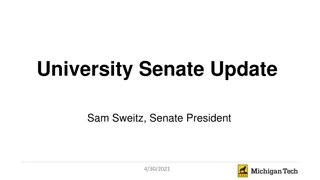Inside the Senate: Roles, Benefits, and Leadership
The Senate, known as the upper house of Congress, holds various privileges and benefits for its members, including a six-year term, substantial salary, tax deductions, and legal immunity during session. Senators are distinguished by formal qualifications such as age and citizenship status. Informal qualifications like age, wealth, and diversity also shape the Senate's composition. The Senate leadership structure, though less powerful than the House, plays crucial roles in executing the party's agenda.
Download Presentation

Please find below an Image/Link to download the presentation.
The content on the website is provided AS IS for your information and personal use only. It may not be sold, licensed, or shared on other websites without obtaining consent from the author.If you encounter any issues during the download, it is possible that the publisher has removed the file from their server.
You are allowed to download the files provided on this website for personal or commercial use, subject to the condition that they are used lawfully. All files are the property of their respective owners.
The content on the website is provided AS IS for your information and personal use only. It may not be sold, licensed, or shared on other websites without obtaining consent from the author.
E N D
Presentation Transcript
Chapter 5: Congress: The Legislative Branch Section 4: The Senate (pg.143-147)
Senate: Terms, Salary, Benefits & Privileges Term: 6 years Salary: Senators-$174,000 President Pro Tempore- $188,100 Majority & Minority Leaders $193,400 Tax deduction for two residences Travel allowances Staff Health and retirement Franking privileges Free printing Use of gym, restaurants, and other amenities in the Capital Legal immunity for statement made while Congress is in session Orrin Hatch, Official Photograph.jpg Orrin Hatch
The Senate and Its Membership It is often called the upper house Senators tend to be better known They have to win statewide election Many House members try to move up to the Senate And many Senators try to become President, although only a few have succeeded. https://upload.wikimedia.org/wikipedia/commons/f/f8/111th_US_Senate_class_photo.jpg
Formal Qualifications http://www.peacecorpsconnect.org/wordpress/wp-content/uploads/2010/07/capitol-building-washington-dc-pictures-1024x768.jpg At least 30 years old-5 years older than House members A citizen for 9 years-2 years longer than House Members A resident of the state they represent In 1913, Senators started to be elected. Only a third are up for election every 2 years, to stop rapid shifts and pose of experienced leaders.
Informal Qualifications Senators are usually older than members of the House Senators are usually wealthier (sometimes called the millionaires club) In 2010, Senate candidates spent over $400 million in 33 races (that s over 12 million each) Congress overall has become more diverse but the Senate has lagged behind, with only 16 women, 1 A/A, 2 Asians, & 2 Hispanic Americans in the Senate. This is not an accurate reflection of U.S. population. There has only been 9 A/A in the Senate. http://thenypost.files.wordpress.com/2013/09/corybooker22006.jpg Cory Booker from NJ the only A/A in the Senate
Senate Leadership The Senate leadership is generally less powerful than the House The official president of the Senate is the VP, but today he doesn t appear unless to break a tie vote President pro tempore is the person who presides in the absence of the VP. It is the senior most Senator from the majority party and is 3rd in line to succeed the president The Senate Majority Leader is the most powerful member and he works to carry out his party s agenda The Senate also has a Minority leader Both leaders have whips http://cdn.arstechnica.net/wp-content/uploads/2015/05/Screen-Shot-2015-05-07-at-1.33.05-PM.png Majority Leader Mitch McConnell
Committees in the Senate https://usatelections.files.wordpress.com/2015/01/harryreid.jpg?w=1000h=733 As in the House the Senate performs much of its work in committees The Senate has 16 standing committees (see list on pg. 146) In general, senators serve on no more than 3 committees and 5 subcommittees. Senators seek assignments that align w/ their interests and needs of their state. The proportion of seats each party receives on a committee reflects numbers in the overall Senate. Committee Chairs hold great power and is based on the seniority rule but starting in 1995 chair could only be in power 6 years. Presidential nominees are usually 1st examined by the relevant Senate committee The Senate also debates and votes on any treaties the government negotiates. Minority Leader Harry Reid
Rules and Traditions Unlike the House the Senate places few limits on debate. A filibuster occurs when opponents of a measure take the floor of the Senate and refuse to stop talking in an effort to prevent the measure coming up for a vote. The minority uses this when they know that the measure is likely to pass if it comes to a vote. In 1917 the Senate trying to limit filibuster, it adopted a rule by which two-thirds vote would impose cloture-an end to debate. In 1975 cloture was lowered to 60 votes. Like the House the Senate can censure (9 times) and expel (15 times) If there is a vacancy usually the governor of that state gets to fill the position until a special election can be held. https://upload.wikimedia.org/wikipedia/commons/5/5a/William-blount-rosenthal-etching-nypl.jpg Expelled Senator William Blount
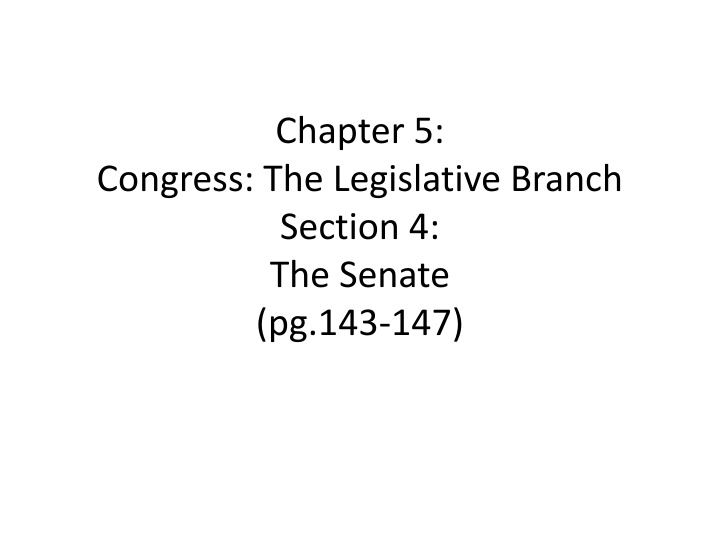

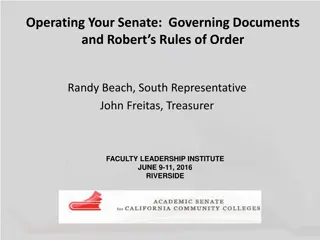


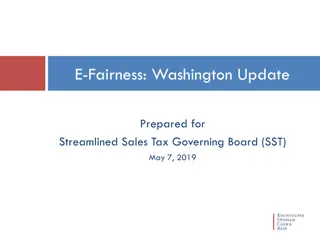




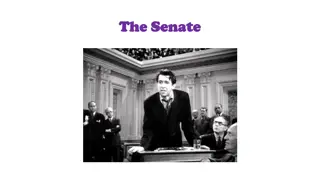





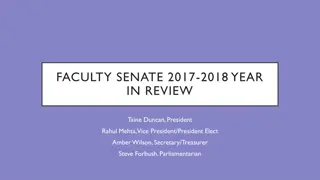





![Overview of the Faculty Senate at [Institution Name]](/thumb/233771/overview-of-the-faculty-senate-at-institution-name.jpg)
